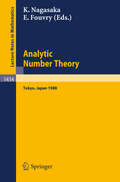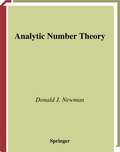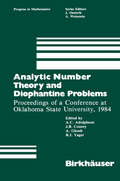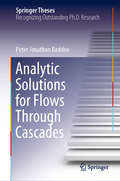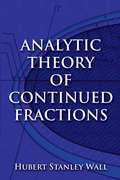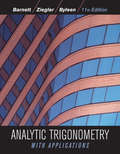- Table View
- List View
Analytic Number Theory: Proceedings of the Japanese-French Symposium held in Tokyo, Japan, October 10-13, 1988 (Lecture Notes in Mathematics #1434)
by Kenji Nagasaka Etienne FouvryAnalytic Number Theory (Graduate Texts in Mathematics #177)
by Donald J. NewmanSome of the central topics in number theory, presnted in a simple and concise fashion. The author covers an amazing amount of material, despite a leisurely pace and emphasis on readability. His heartfelt enthusiasm enables readers to see what is magical about the subject. All the topics are presented in a refreshingly elegant and efficient manner with clever examples and interesting problems throughout. The text is suitable for a graduate course in analytic number theory.
Analytic Number Theory: In Honor of Helmut Maier’s 60th Birthday
by Carl Pomerance Michael Th. RassiasThis volume contains a collection of research and survey papers written by some of the most eminent mathematicians in the international community and is dedicated to Helmut Maier, whose own research has been groundbreaking and deeply influential to the field. Specific emphasis is given to topics regarding exponential and trigonometric sums and their behavior in short intervals, anatomy of integers and cyclotomic polynomials, small gaps in sequences of sifted prime numbers, oscillation theorems for primes in arithmetic progressions, inequalities related to the distribution of primes in short intervals, the Möbius function, Euler’s totient function, the Riemann zeta function and the Riemann Hypothesis. Graduate students, research mathematicians, as well as computer scientists and engineers who are interested in pure and interdisciplinary research, will find this volume a useful resource.Contributors to this volume:Bill Allombert, Levent Alpoge, Nadine Amersi, Yuri Bilu, Régis de la Bretèche, Christian Elsholtz, John B. Friedlander, Kevin Ford, Daniel A. Goldston, Steven M. Gonek, Andrew Granville, Adam J. Harper, Glyn Harman, D. R. Heath-Brown, Aleksandar Ivić, Geoffrey Iyer, Jerzy Kaczorowski, Daniel M. Kane, Sergei Konyagin, Dimitris Koukoulopoulos, Michel L. Lapidus, Oleg Lazarev, Andrew H. Ledoan, Robert J. Lemke Oliver, Florian Luca, James Maynard, Steven J. Miller, Hugh L. Montgomery, Melvyn B. Nathanson, Ashkan Nikeghbali, Alberto Perelli, Amalia Pizarro-Madariaga, János Pintz, Paul Pollack, Carl Pomerance, Michael Th. Rassias, Maksym Radziwiłł, Joël Rivat, András Sárközy, Jeffrey Shallit, Terence Tao, Gérald Tenenbaum, László Tóth, Tamar Ziegler, Liyang Zhang.
Analytic Number Theory and Diophantine Problems: Proceedings of a Conference at Oklahoma State University, 1984 (Progress in Mathematics #70)
by A. C. Adolphson A. Ghosh J. B. Conrey R. I. JagerA conference on Analytic Number Theory and Diophantine Problems was held from June 24 to July 3, 1984 at the Oklahoma State University in Stillwater. The conference was funded by the National Science Foundation, the College of Arts and Sciences and the Department of Mathematics at Oklahoma State University. The papers in this volume represent only a portion of the many talks given at the conference. The principal speakers were Professors E. Bombieri, P. X. Gallagher, D. Goldfeld, S. Graham, R. Greenberg, H. Halberstam, C. Hooley, H. Iwaniec, D. J. Lewis, D. W. Masser, H. L. Montgomery, A. Selberg, and R. C. Vaughan. Of these, Professors Bombieri, Goldfeld, Masser, and Vaughan gave three lectures each, while Professor Hooley gave two. Special sessions were also held and most participants gave talks of at least twenty minutes each. Prof. P. Sarnak was unable to attend but a paper based on his intended talk is included in this volume. We take this opportunity to thank all participants for their (enthusiastic) support for the conference. Judging from the response, it was deemed a success. As for this volume, I take responsibility for any typographical errors that may occur in the final print. I also apologize for the delay (which was due to the many problems incurred while retyping all the papers). A. special thanks to Dollee Walker for retyping the papers and to Prof. W. H. Jaco for his support, encouragement and hard work in bringing the idea of the conference to fruition.
Analytic Number Theory, Approximation Theory, and Special Functions: In Honor of Hari M. Srivastava
by Gradimir V. Milovanović Michael Th. RassiasThis book, in honor of Hari M. Srivastava, discusses essential developments in mathematical research in a variety of problems. It contains thirty-five articles, written by eminent scientists from the international mathematical community, including both research and survey works. Subjects covered include analytic number theory, combinatorics, special sequences of numbers and polynomials, analytic inequalities and applications, approximation of functions and quadratures, orthogonality and special and complex functions.The mathematical results and open problems discussed in this book are presented in a simple and self-contained manner. The book contains an overview of old and new results, methods, and theories toward the solution of longstanding problems in a wide scientific field, as well as new results in rapidly progressing areas of research. The book will be useful for researchers and graduate students in the fields of mathematics, physics and other computational and applied sciences.
Analytic Number Theory, Modular Forms and q-Hypergeometric Series: In Honor of Krishna Alladi's 60th Birthday, University of Florida, Gainesville, March 2016 (Springer Proceedings in Mathematics & Statistics #221)
by George E. Andrews Frank GarvanGathered from the 2016 Gainesville Number Theory Conference honoring Krishna Alladi on his 60th birthday, these proceedings present recent research in number theory. Extensive and detailed, this volume features 40 articles by leading researchers on topics in analytic number theory, probabilistic number theory, irrationality and transcendence, Diophantine analysis, partitions, basic hypergeometric series, and modular forms. Readers will also find detailed discussions of several aspects of the path-breaking work of Srinivasa Ramanujan and its influence on current research. Many of the papers were motivated by Alladi's own research on partitions and q-series as well as his earlier work in number theory. Alladi is well known for his contributions in number theory and mathematics. His research interests include combinatorics, discrete mathematics, sieve methods, probabilistic and analytic number theory, Diophantine approximations, partitions and q-series identities. Graduate students and researchers will find this volume a valuable resource on new developments in various aspects of number theory.
Analytic Partial Differential Equations (Grundlehren der mathematischen Wissenschaften #359)
by François TrevesThis book provides a coherent, self-contained introduction to central topics of Analytic Partial Differential Equations in the natural geometric setting. The main themes are the analysis in phase-space of analytic PDEs and the Fourier–Bros–Iagolnitzer (FBI) transform of distributions and hyperfunctions, with application to existence and regularity questions.The book begins by establishing the fundamental properties of analytic partial differential equations, starting with the Cauchy–Kovalevskaya theorem, before presenting an integrated overview of the approach to hyperfunctions via analytic functionals, first in Euclidean space and, once the geometric background has been laid out, on analytic manifolds. Further topics include the proof of the Lojaciewicz inequality and the division of distributions by analytic functions, a detailed description of the Frobenius and Nagano foliations, and the Hamilton–Jacobi solutions of involutive systems of eikonal equations. The reader then enters the realm of microlocal analysis, through pseudodifferential calculus, introduced at a basic level, followed by Fourier integral operators, including those with complex phase-functions (à la Sjöstrand). This culminates in an in-depth discussion of the existence and regularity of (distribution or hyperfunction) solutions of analytic differential (and later, pseudodifferential) equations of principal type, exemplifying the usefulness of all the concepts and tools previously introduced. The final three chapters touch on the possible extension of the results to systems of over- (or under-) determined systems of these equations—a cornucopia of open problems.This book provides a unified presentation of a wealth of material that was previously restricted to research articles. In contrast to existing monographs, the approach of the book is analytic rather than algebraic, and tools such as sheaf cohomology, stratification theory of analytic varieties and symplectic geometry are used sparingly and introduced as required. The first half of the book is mainly pedagogical in intent, accessible to advanced graduate students and postdocs, while the second, more specialized part is intended as a reference for researchers.
Analytic Pseudo-Differential Operators and their Applications (Mathematics and its Applications #68)
by Julii A. DubinskiiAnalytic Pseudodifferential Operators for the Heisenberg Group and Local Solvability. (MN-37) (PDF)
by Daryl GellerMany of the operators one meets in several complex variables, such as the famous Lewy operator, are not locally solvable. Nevertheless, such an operator L can be thoroughly studied if one can find a suitable relative parametrix--an operator K such that LK is essentially the orthogonal projection onto the range of L. The analysis is by far most decisive if one is able to work in the real analytic, as opposed to the smooth, setting. With this motivation, the author develops an analytic calculus for the Heisenberg group. Features include: simple, explicit formulae for products and adjoints; simple representation-theoretic conditions, analogous to ellipticity, for finding parametrices in the calculus; invariance under analytic contact transformations; regularity with respect to non-isotropic Sobolev and Lipschitz spaces; and preservation of local analyticity. The calculus is suitable for doing analysis on real analytic strictly pseudoconvex CR manifolds. In this context, the main new application is a proof that the Szego projection preserves local analyticity, even in the three-dimensional setting. Relative analytic parametrices are also constructed for the adjoint of the tangential Cauchy-Riemann operator.Originally published in 1990.The Princeton Legacy Library uses the latest print-on-demand technology to again make available previously out-of-print books from the distinguished backlist of Princeton University Press. These editions preserve the original texts of these important books while presenting them in durable paperback and hardcover editions. The goal of the Princeton Legacy Library is to vastly increase access to the rich scholarly heritage found in the thousands of books published by Princeton University Press since its founding in 1905.
Analytic Solutions for Flows Through Cascades (Springer Theses)
by Peter Jonathan BaddooThis thesis is concerned with flows through cascades, i.e. periodic arrays of obstacles. Such geometries are relevant to a range of physical scenarios, chiefly the aerodynamics and aeroacoustics of turbomachinery flows. Despite the fact that turbomachinery is of paramount importance to a number of industries, many of the underlying mechanisms in cascade flows remain opaque. In order to clarify the function of different physical parameters, the author considers six separate problems. For example, he explores the significance of realistic blade geometries in predicting turbomachinery performance, and the possibility that porous blades can achieve noise reductions. In order to solve these challenging problems, the author deploys and indeed develops techniques from across the spectrum of complex analysis: the Wiener–Hopf method, Riemann–Hilbert problems, and the Schottky–Klein prime function all feature prominently. These sophisticated tools are then used to elucidate the underlying mathematical and physical structures present in cascade flows. The ensuing solutions greatly extend previous works and offer new avenues for future research. The results are not of simply academic value but are also useful for aircraft designers seeking to balance aeroacoustic and aerodynamic effects.
Analytic SQL in SQL Server 2014/2016
by Riadh GhlalaBusiness Intelligence (BI) has emerged as a field which seeks to support managers in decision-making. It encompasses the techniques, methods and tools for conducting analytically-based IT solutions, which are referred to as OLAP (OnLine Analytical Processing). Within this field, SQL has a role as a leader and is continuously evolving to cover both transactional and analytical data management. This book discusses the functions provided by Microsoft® SQL Server 2014/2016 in terms of business intelligence. The analytic functions are considered as an enrichment of the SQL language. They combine a series of practical functions to answer complex analysis requests with all the simplicity, elegance and acquired performance of the SQL language. Drawing on the wide experience of the author in teaching and research, as well as insights from contacts in the industry, this book focuses on the issues and difficulties faced by academics (students and teachers) and professionals engaged in data analysis with the SQL Server 2014/2016 database management system.
Analytic SQL in SQL Server 2014/2016
by Riadh GhlalaBusiness Intelligence (BI) has emerged as a field which seeks to support managers in decision-making. It encompasses the techniques, methods and tools for conducting analytically-based IT solutions, which are referred to as OLAP (OnLine Analytical Processing). Within this field, SQL has a role as a leader and is continuously evolving to cover both transactional and analytical data management. This book discusses the functions provided by Microsoft® SQL Server 2014/2016 in terms of business intelligence. The analytic functions are considered as an enrichment of the SQL language. They combine a series of practical functions to answer complex analysis requests with all the simplicity, elegance and acquired performance of the SQL language. Drawing on the wide experience of the author in teaching and research, as well as insights from contacts in the industry, this book focuses on the issues and difficulties faced by academics (students and teachers) and professionals engaged in data analysis with the SQL Server 2014/2016 database management system.
Analytic Theory of Continued Fractions: Proceedings of a Seminar-Workshop Held at Loen, Norway, 1981 (Lecture Notes in Mathematics #932)
by W. B. Jones W. J. Thron H. WaadelandAnalytic Theory of Continued Fractions (Dover Books on Mathematics)
by Hubert Stanley WallOne of the most authoritative and comprehensive books on the subject of continued fractions, this monograph has been widely used by generations of mathematicians and their students. Dr. Hubert Stanley Wall presents a unified theory correlating certain parts and applications of the subject within a larger analytic structure. Prerequisites include a first course in function theory and knowledge of the elementary properties of linear transformations in the complex plane. Some background in number theory, real analysis, and complex analysis may also prove helpful. The two-part treatment begins with an exploration of convergence theory, addressing continued fractions as products of linear fractional transformations, convergence theorems, and the theory of positive definite continued fractions, as well as other topics. The second part, focusing on function theory, covers the theory of equations, matrix theory of continued fractions, bounded analytic functions, and many additional subjects.
Analytic Theory of Continued Fractions II: Proceedings of a Seminar-Workshop held in Pitlochry and Aviemore, Scotland June 13 –29, 1985 (Lecture Notes in Mathematics #1199)
by Wolfgang J. ThronAnalytic Theory of Continued Fractions III: Proceedings of a Seminar-Workshop, held in Redstone, USA, June 26 - July 5, 1988 (Lecture Notes in Mathematics #1406)
by Lisa JacobsenAnalytic Theory of Differential Equations: The Proceedings of the Conference at Western Michigan University, Kalamazoo, from 30 April to 2 May 1970 (Lecture Notes in Mathematics #183)
by P. F. Hsieh A. W. J. StoddartAnalytic Theory of Global Bifurcation (PDF)
by Boris Buffoni John TolandRabinowitz's classical global bifurcation theory, which concerns the study in-the-large of parameter-dependent families of nonlinear equations, uses topological methods that address the problem of continuous parameter dependence of solutions by showing that there are connected sets of solutions of global extent. Even when the operators are infinitely differentiable in all the variables and parameters, connectedness here cannot in general be replaced by path-connectedness. However, in the context of real-analyticity there is an alternative theory of global bifurcation due to Dancer, which offers a much stronger notion of parameter dependence. This book aims to develop from first principles Dancer's global bifurcation theory for one-parameter families of real-analytic operators in Banach spaces. It shows that there are globally defined continuous and locally real-analytic curves of solutions. In particular, in the real-analytic setting, local analysis can lead to global consequences--for example, as explained in detail here, those resulting from bifurcation from a simple eigenvalue. Included are accounts of analyticity and implicit function theorems in Banach spaces, classical results from the theory of finite-dimensional analytic varieties, and the links between these two and global existence theory. Laying the foundations for more extensive studies of real-analyticity in infinite-dimensional problems and illustrating the theory with examples, Analytic Theory of Global Bifurcation is intended for graduate students and researchers in pure and applied analysis.
Analytic Theory of Itô-Stochastic Differential Equations with Non-smooth Coefficients (SpringerBriefs in Probability and Mathematical Statistics)
by Haesung Lee Wilhelm Stannat Gerald TrutnauThis book provides analytic tools to describe local and global behavior of solutions to Itô-stochastic differential equations with non-degenerate Sobolev diffusion coefficients and locally integrable drift. Regularity theory of partial differential equations is applied to construct such solutions and to obtain strong Feller properties, irreducibility, Krylov-type estimates, moment inequalities, various types of non-explosion criteria, and long time behavior, e.g., transience, recurrence, and convergence to stationarity. The approach is based on the realization of the transition semigroup associated with the solution of a stochastic differential equation as a strongly continuous semigroup in the Lp-space with respect to a weight that plays the role of a sub-stationary or stationary density. This way we obtain in particular a rigorous functional analytic description of the generator of the solution of a stochastic differential equation and its full domain. The existence of such a weight is shown under broad assumptions on the coefficients. A remarkable fact is that although the weight may not be unique, many important results are independent of it. Given such a weight and semigroup, one can construct and further analyze in detail a weak solution to the stochastic differential equation combining variational techniques, regularity theory for partial differential equations, potential, and generalized Dirichlet form theory. Under classical-like or various other criteria for non-explosion we obtain as one of our main applications the existence of a pathwise unique and strong solution with an infinite lifetime. These results substantially supplement the classical case of locally Lipschitz or monotone coefficients.We further treat other types of uniqueness and non-uniqueness questions, such as uniqueness and non-uniqueness of the mentioned weights and uniqueness in law, in a certain sense, of the solution.
Analytic Tools for Feynman Integrals (Springer Tracts in Modern Physics)
by Vladimir A. SmirnovThe goal of this book is to describe the most powerful methods for evaluating multiloop Feynman integrals that are currently used in practice. This book supersedes the author’s previous Springer book “Evaluating Feynman Integrals” and its textbook version “Feynman Integral Calculus.” Since the publication of these two books, powerful new methods have arisen and conventional methods have been improved on in essential ways. A further qualitative change is the fact that most of the methods and the corresponding algorithms have now been implemented in computer codes which are often public.In comparison to the two previous books, three new chapters have been added: One is on sector decomposition, while the second describes a new method by Lee. The third new chapter concerns the asymptotic expansions of Feynman integrals in momenta and masses, which were described in detail in another Springer book, “Applied Asymptotic Expansions in Momenta and Masses,” by the author. This chapter describes, on the basis of papers that appeared after the publication of said book, how to algorithmically discover the regions relevant to a given limit within the strategy of expansion by regions. In addition, the chapters on the method of Mellin-Barnes representation and on the method of integration by parts have been substantially rewritten, with an emphasis on the corresponding algorithms and computer codes.
Analytic Trigonometry with Applications
by Raymond A. Barnett Michael R. Ziegler Karl E. ByleenBarnett, Analytic Trigonometry is a text that students can actually read, understand, and apply. Concept development moves from the concrete to abstract to engage the student. Almost every concept is illustrated by an example followed by a matching problem allowing students to practice knowledge precisely when they acquire it. To gain student interest quickly, the text moves directly into trigonometric concepts and applications and reviews essential material from prerequisite courses only as needed. Extensive chapter review summaries, chapter and cumulative review exercises with answers keyed to the corresponding text sections, effective use of color comments and annotations, and prominent displays of important material all help the student master the subject. Analytic Trigonometry 11th edition includes updated applications from a range of different fields to convince all students that trigonometry is really useful.
Analytical and Computational Methods in Probability Theory: First International Conference, ACMPT 2017, Moscow, Russia, October 23-27, 2017, Proceedings (Lecture Notes in Computer Science #10684)
by Vladimir V. Rykov Nozer D. Singpurwalla Andrey M. ZubkovThis book constitutes the refereed proceedings of the First International Conference on Analytical and Computational Methods in Probability Theory and its Applications, ACMPT 2017, held in Moscow, Russia, in October 2017. The 42 full papers presented were carefully reviewed and selected from 173 submissions. The conference program consisted of four main themes associated with significant contributions made by A.D.Soloviev. These are:Analytical methods in probability theory,Computational methods in probability theory,Asymptotical methods in probability theory, the history of mathematics.
Analytical and Computational Methods of Advanced Engineering Mathematics (Texts in Applied Mathematics #28)
by Grant B. Gustafson Calvin H. WilcoxThis book focuses on the topics which provide the foundation for practicing engineering mathematics: ordinary differential equations, vector calculus, linear algebra and partial differential equations. Destined to become the definitive work in the field, the book uses a practical engineering approach based upon solving equations and incorporates computational techniques throughout.
Analytical and Numerical Approaches to Mathematical Relativity (Lecture Notes in Physics #692)
by Jörg Frauendiener Roger Penrose Domenico J. W. Giulini Volker PerlickGeneral relativity ranks among the most accurately tested fundamental theories in all of physics. Deficiencies in mathematical and conceptual understanding still exist, hampering further progress. This book collects surveys by experts in mathematical relativity writing about the current status of, and problems in, their fields. There are four contributions for each of the following mathematical areas: differential geometry and differential topology, analytical methods and differential equations, and numerical methods.
